| Komyoji Temple (光明寺) |
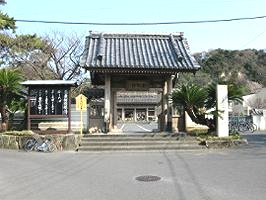
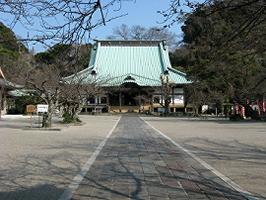
Full name;Tenshozan Komyoji (天照山 光明寺)
Denomination:Jodo sect (浄土宗)
Location: 1.6 kilometers south of JR Kamakura Station
History: Komyoji was built in 1243 by Hojo Tsunetoki (北条経時, 1224-46), the fourth regent of the Kamakura bakufu, who appointed Nen'a Ryochu (燃阿良忠, 1199-1287) as the founding priest.
Ryochu, from Iwami Province (石見, present-day Shimane Prefecture), had learned the teachings of the Jodo sect from Shoko (聖光), who was a disciple of Honen (法然, 1133-1212), the founder of this sect.
The Jodo sect is said to have become popular around the Kanto and Tohoku regions from the time Ryochu settled in Kamakura and actively propagated its teachings.
Ryochu was so virtuous and learned that when he died at the age of 89 in 1287, Emperor Fushimi (伏見天皇, 1265-1317) bestowed the title Kishu Zenji (記主禅師) on him. The temple thrived, enjoying the support of successive regents of the Kamakura government.
Furthermore, in the late fifteenth century, Emperor Go-Tsuchimikado (後土御門天皇, 1442-1500), impressed by the virtue of Kan'yo Yuso (観誉祐崇), recognized Komyoji as a chokuganji (勅願寺), which meant the temple was virtually given the same rank as Todaiji (東大寺) and Yakushiji (薬師寺), in Nara, temples that were also built by imperial decree. Komyoji was then permitted to hold a Buddhist ceremony called juyahoe (十夜法会), "successive ten night memorial service."
The temple once fell into decline but revived when Tokugawa Ieyasu (徳川家康, 1542-1616) designated it as one of the 18 academic temples (juhachi-danrin, 十八壇林) of the Jodo sect for the study of Buddhist doctrine. With tracts of land donated by Ieyasu and later by the Naito (内藤), feudal lords of Hyuga Province (日向, present-day Miyazaki Prefecture), the temple prospered as the family temple of the Naito.
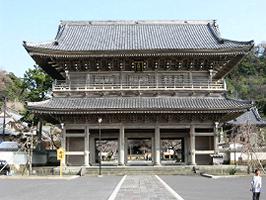
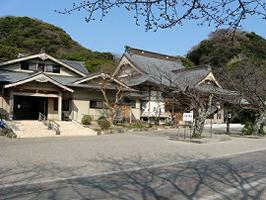
Grounds: The Somon Gate (総門) and the massive Sammon Gate beyond it will come into sight on the left from the main road as you approach the temple. Komyoji, along with Kenchoji (建長寺) and Engakuji (円覚寺), is one of the major temples in Kamakura.
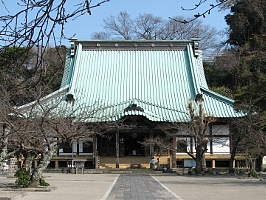
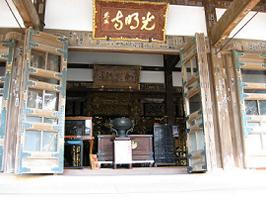
To the right of the Somon Gate stand two stone monuments: the first bears the inscription 関東総本山 (Head Temple of the Shingo Sect in the Kanto Region), and the second says 大本山光明寺 (Head Temple, Komyoji). The Somon Gate has a plaque with the characters 勅願所 (chokugansho), a term that refers to a temple built at the behest of an emperor, and carvings of dragons on the transom.
Beyond the Somon Gate lie spacious grounds that include Senjuin (千手院) to the left and Renjoin (蓮乗院) to the right, and the Sammon Gate in front. This Sammon Gate, constructed in 1847, is in the style of a two-storied gate called niju-mon, 二重門, the largest of this style in Kamakura. The second part of the structure is built in the Zen-sect style (禅宗様) with the lower part in the Wayo style (和様), or Japanese style.
The panel on the gate bears the inscription 天照山 (Tenshozan), said to have been written by Emperor Go-Hanazono (後花園, 1419-70), with the year name 永享八年 (corresponding to 1436) on its back. The panel, nearly as large as a tatami mat, is reputed to be one of the largest in the Kanto region. The second floor of the gate houses statues of Shaka Nyorai, Monju Bosatsu (文殊菩薩) and Fugen Bosatsu (普賢菩薩), both are the attendants of Shaka Nyorai, Shitenno (四天王), and Juroku Rakan (十六羅漢).
*The major architectural differences between the Zen-sect style (禅宗様), a.k.a. Karayo style (唐様), and the Wayo style (和様) are:
1. In the Zen-sect style, horizontal beams, called nuki (貫), in the frame pierce the pillar, whereas in the Wayo style, non-penetrating tie beams (nageshi, 長押) are nailed to both sides of the pillar;
2. The Zen-sect style has pillars rounded at the top and/or bottom;
3. The bracket system that supports the eaves is located both between pillars as well as on the pillars, but in the Wayo-style, the brackets are on the pillars only, not between them;
4. Wooden wallboards in the Zen-sect style are set vertically, not horizontally as in the Wayo-style;
5. A cusped windows (kato-mado, 花頭窓 or 火灯窓) are used in the Zen-sect style;
6. Rafters radiate like the ribs of an unfolded fan in the Zen-sect style.
Generally, a somon gate is also called gemon (外門, outer gate), and a sammon is called chumon (中門, middle gate). These gates lead to a Main Hall, where one transports oneself to the Buddhist world.
Beyond the Sammon Gate stands the Main Hall, where people pray or simply view the elaborately decorated inner sanctuary.
To the right (when facing the Main Hall) is a bell tower, and to the left is Kaisando Hall (開山堂, Founder's Hall). Behind it are Kyakuden Hall (客殿, Guest Hall), the Kuri (庫裏, Priests' Living Quarters), the Hombo (本坊, Lodgings), and the Shoin (書院, Study).
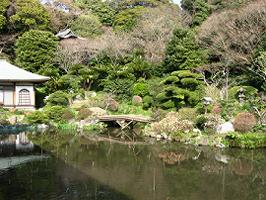
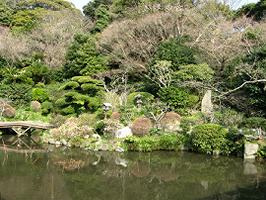
At the rear left of the Main Hall lies a garden with a lotus pond called Kishuteien (記主庭園), in Jodo style: a reproduction of the Pure Land in the West where Amida Buddha resides. It was commissioned by Kobori Enshu (小堀遠州, 1579-1647), a tea master, reputed garden designer and architect in the Edo period (1603-1867). He taught the tea ceremony to shoguns and feudal lords and oversaw the construction of Nagoya (名古屋城) and Nijo Castles (二条城).
The lotus in this pond are known as nisen-nen hasu (二千年蓮), "two-thousand-year-old lotus," since their seeds were found at a Yayoi period site (300 BC-300 AD) and were then grown by Dr. Oga Ichiro (大賀一郎, 1883-1965). At a Yayoi period excavation site in Kemigawa (検見川, in Chiba Prefecture) he had found some lotus seeds that were buried some two thousand years before, and succeeded in bringing them into blossom. In early summer mornings, the lotus come into full bloom on the surface of the pond.
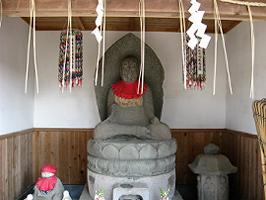
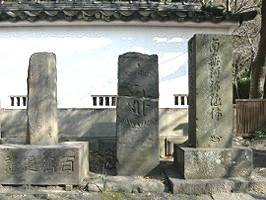
To the right side of the Main Hall stands a Jizodo Hall, which houses a stone statue of Jizo, called Amihiki Jizo (網引地蔵), with the inscription 正中二年 (corresponding to 1325), and off to the right is a stone slab, itabi (板碑), said to be the mate of the one in the grounds of Gosho Shrine (五所神社).
On the right side of the Main Hall is a newly-built garden called Sanzon Goso Raigo no Niwa, 三尊五祖来迎の庭. The garden is in the karesansui (枯山水), or "dry landscape" style, which uses stone arrangement, white sand, and shrubs to symbolize a sea, ponds or streams. The stones represent three Buddhist images and five great priests of the Jodo sect.
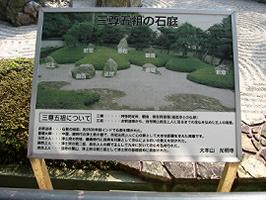
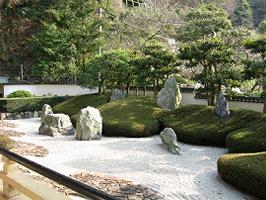
The sanzon in the garden name refers to Amida Nyorai, Kannon Bosatsu, and Seishi Bosatsu, and goso, literally five founders (of the Jodo sect), to Shakyamuni (釈迦), Zendo (善導), Honen (法然), Chinzei (鎮西), and Kishu (記主). Explanations about the layout of the garden can be found on the nearby guidepost: Zendo (613-681) is a Chinese priest in the Tang period and his works and teachings greatly effected Honen; Cinzei (1162-1238), a.k.a. Bencho (弁長) or Ben'a (弁阿), is revered as the second founder of this sect, and was active in Kyushu in propagating the practice of Nembutsu (念仏).
The veranda skirting the Main Hall provides the visitor an opportunity to relax while viewing the garden.
The temple houses a number of treasures: the Taima Mandara Engi Emaki (当麻曼荼羅縁起絵巻), a picture scroll masterpiece drawn in yamatoe-style, designated a National Treasure. (a donation of the Naito family and now entrusted to the Kamakura Kokuhokan Museum).
There are also drawings of Jodo Goso Ezu (浄土五祖絵図, five founders of the Jodo sect) and Juhachi Rakan and Sozo (十八羅漢及僧像, 18-Arhats and priests), both designated Important Cultural Properties.
The temple also has many statues: Amida-sanzon (阿弥陀三尊), the principal image, and a seated, wooden image of Kishu. In the inner sanctuary of the Main Hall is a statue of Amida Nyorai (above mentioned Amida-sanzon).
To its left is a statue of Naito Tadaoki (内藤忠興), a feudal lord, who changed his family temple to Komyoji and supported the temple with donations of tracts of land and valuable drawings.
To the right of the main image are Benzaiten (弁才天), and a wooden statue of Zendo, a high-ranking priest and the founder of the Jodo sect of Buddhism in China. Zendo was highly virtuous, and Honen, the founder of the Jodo sect in Japan, revered him deeply.
In front of Kaisando Hall are a stone statue of Zendo and a stone monument inscribed with the characters 善導塚 (Zendozuka). Between the two characters導 (do) and 塚 (zuka or tsuka) is a square hole with a small statue of Zendo within.
The temple is well known for its religious service called ojuya (お十夜), literally, "Ten Nights." Originally, this was a service of the Jodo sect held for ten days from October 6 to 15, which is said to have begun in the mid-fifteenth century when Taira no Sadakuni (平貞国) confined himself in its Shinnyodo Hall (真如堂) and held a Buddhist service in which he chanted sutras for ten consecutive days during the reign of Emperor Go-Hanazono.
The temple now holds the ojuya service from October 12 to 15, and people from within and without the city come to the grounds. Stalls selling various kinds of plants line both sides of the street.
| Senjuin (千手院) |
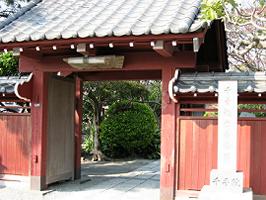
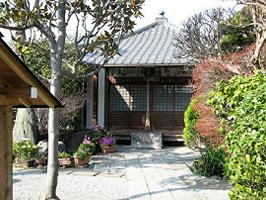
Full name;Tenshozan Senjuin (天照山 千手院)
Denomination:Shingon sect (真言宗)
Location: Senjuin will be found to the left between the Somon and Sammon Gates of Komyoji Temple
History: In the Edo period, when Komyoji functioned as Dai-danrin (大壇林, supreme place for studying Buddhism), many monks who gathered from across the country stayed at Senjuin. Successive head priests of the temple, called gakuto (学頭, study leader) were leaders of those monks. From the middle of the Edo period, as the number of monks who came to study dwindled, the temple taught local children reading, writing, and calculation on the soroban (算盤).
It is now a sub-temple of Komyoji, with its own Sammon Gate and is surrounded by vermilion fence.
Grounds: In the grounds you will see many stone monuments, one of which was erected as a commemorative stone marking the site as one of the 33 in the Kannon Pilgrimage Circuit "坂東三十三ケ所観音霊場." Beyond the approach are the Main Hall and the priest's living quarters.
The main image of the temple is that of Amida Nyorai, but the name of the temple is still called Senjuin after the renowned Senju Kannon (千手観音, Thousand-armed Kannon), which had originally been enshrined in the Main Hall but has long since disappeared).
| Renjoin (蓮乗院) |
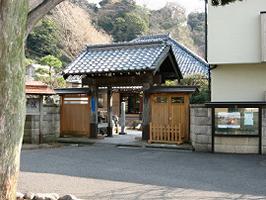
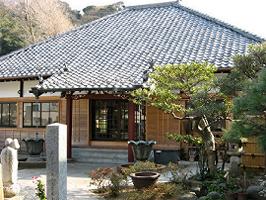
Full name;Tenshozan Rengein (天照山 蓮華院)
Denomination:Shingon sect (真言宗)
Location: Renjoin is to the right of the Sammon Gate of Komyoji Temple
History: It is not clear when the temple was founded or who the first priest was. It is said, however, that the temple was already here when Komyoji was moved to this location from Sasukegayatsu (佐助ケ谷) in 1243. At that time, the name of the temple was changed from Renjoji to the present Renjoin and became a sub-temple of Komyoji. Until the completion of Komyoji in 1243, Ryochu lodged at Renjoin. Following this precedent, successive priests at Komyoji even now stay first at Renjoin, then go to Komyoji.
Grounds: When you pass through the Sammon Gate of its own, you will see the Main Hall in front, the Kuri behind the Main Hall and the bell tower to the right.
The main image is Amida Nyorai, said to have been worshiped as a guardian saint by Chiba Tsunetane (千葉常胤, 1118-1201). Since the Chiba family and the temple have the same type of crest (月星, tsukiboshi, the moon and a star), it is presumed that the temple had a relationship of some sort with the Chiba.
The temple houses several treasures. The 82-centimeter main image is a rarity in that the name of the sculptor and the time of carving were identified by documents in its body stating that the statue was made in 1299 by Hokyo Soen (法橋宗円). In addition to this statue, more than ten others are also here, including Juichinen Kannon, Zendo, Honen, Amida Nyorai, Shaka Nyorai, and Kobo Daishi.
Other valuable assets include drawings of flowers and birds on the sliding panels, and similar drawings on the ceiling, which bring to mind the Western Paradise in Buddhism.
| Graveyard of the Naito (内藤家の墓地) |
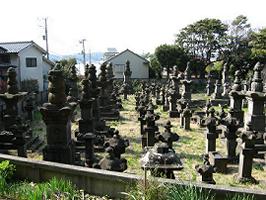
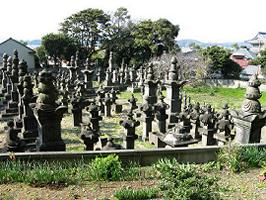
Location: 1.9 kilometers south of JR Kamakura Station
Grounds The grounds and tombstones, closed to casual visitors, can be seen only from the slope, and include the graves of the Naito lords of Hyuga Province (日向, present-day Miyazaki Prefecture) and Iwaki Province (磐城, present-day Fukushima Prefecture).
There are 58 tombstones and mortuary monuments of various types, among which are 39 stupas in hokyointo-type, 13 in kasatoba-type (笠塔婆, roofed-fivefold tombstone), and 4 stone Buddhist images, plus 118 stone lanterns and 17 stone basins for hand washing. The hokyointo here were made throughout the Edo period, and thus provide useful information on how their styles changed over the years.
| Zaimokuza Beach (材木座海岸) |
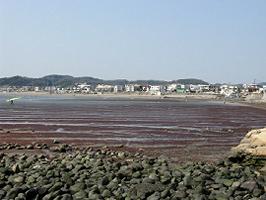
Location Zaimokuza Beach, contingent to Yuigahama Beach, lies to the southwest of Komyoji Temple. The borderline between the beaches is the Namerigawa River (滑川). In 1964, a highway was constructed along the beach from Namerigawaguchi (滑川口) to Zushi, and gradually the surroundings have changed.
Story: There is a story that recounts an unrealized dream held by Minamoto no Sanetomo (源実朝, 1192-1219), the third shogun. In 1216, he determined to visit China following the advice of Chin Nakei (陳和卿, ?-?), who had come from China on a mission to reconstruct the Todaiji in Nara. Construction of a ship was completed in April of 1217, and preparations were made to set sail, including some 60 attendants.
The ship, however, was unable to float, since the body was too heavy and the shore too shallow. Sanetomo's ambitious hope to journey to China was thus shattered, only one step away from its realization. It is recorded that the ship was afterwards long abandoned and left to weather into decay.
| Wakaejima (和賀江島) |
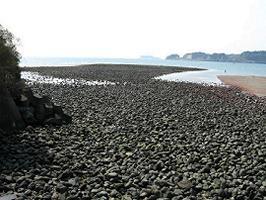
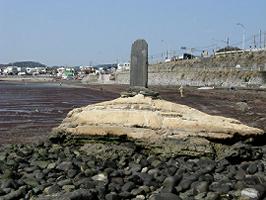
Wakaejima is the site of what used to be a port, a portion of which still remains: a stretch of piled stones protruding into the sea just below the road that runs toward the tunnel to Zushi.
A large rocks on the beach serves as a marker of the former port, and on which stands a stone monument with the explanation of the old port, now, designated a Historic Site by the government.
Another signboard nearby erected by the Kanagawa Prefecture Board of Education explains that Wakaejima is the oldest of the remaining man-made ports in Japan.
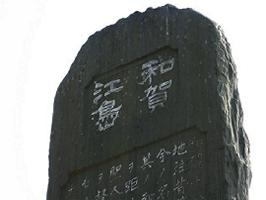
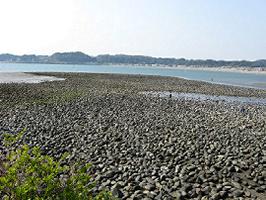
In the Kamakura period, this area was called Wakaenotsu (和賀江津) and prospered on trade, with numbers of ships arriving from and departing for various ports in the country. Due to the shallowness of the water, however, it was inconvenient for loading and unloading large ships. Also, ships sometimes sank when there was a strong wind and the sea was rough. A priest named Oamidabutsu (往阿弥陀仏) thereupon decided to build a port, and was granted permission from the government in 1232.
With the support of Hojo Yasutoki (北条泰時, 1183-1242), the third regent, who assigned an official as supervisor, Oamidabutsu completed the work in approximately one month.
The first port had the dual functions of a breakwater and a kind of wharf. The structure consisted of large stones laid out under the seabed as a foundation, with smaller, round stones then piled atop the former. The materials were transported from the Sagamigawa (相模川) and Sakawagawa (酒匂川) Rivers and the Izu Peninsula.
The undertaking probably started on a small scale and was gradually extended to the size it had in its heyday. Even today, there are places where large stones probably used for the foundation are visible.
Records state that when the port was damaged by waves, Ninsho (忍性, 1217-1303), a celebrated priest at Gokurakuji (極楽寺), collected money for repairs from ships that called at the port. Successive priests at the temple continued the practice, and the port is said to have been used until the end of the Edo period.
| Rokkaku no I Well (六角ノ井) |
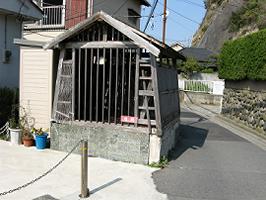
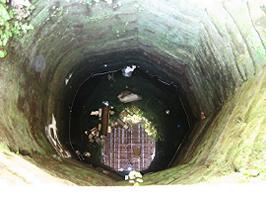
The area called Iijima is in the southeast sector of Kamakura and borders the city of Zushi. The name "Iijima" was used from the time of the Kamakura period, and appears in the Azuma Kagami (吾妻鏡), a historical record of events between 1180 and 1267, compiled by the Kamakura government. The area of Kotsubo (小坪) was a fishing village, but as its nickname, Saginoura (鷺の浦, "Inlet of Herons"), suggests, its scenery was beautiful and successive shoguns in the Kamakura period often visited to enjoy it.
On the roadside near Wakaejima is a well called Rokkaku no I, one of ten wells in old Kamakura. It is no longer used, but is covered and protected by a shed-like structure. Despite being called Rokkaku, which means a hexagon, the frame of the well is actually formed of eight sides. A nearby plaque explains that six of the eight sides belong to Kamakura and the rest to Zushi. The well is also popularly called Yanone no I (矢の根の井), "Arrowhead Well."
A story recounting how the well acquired its name goes back to the time of Minamoto no Tametomo (源為朝, 1139-70). He, the uncle of Yoritomo, was the eighth son of Tameyoshi (為義, 1096-1156) and was reputed to be a skillful archer. More than two meters tall, he had even more of an advantage as an archer in that his left arm was 10 centimeters longer than his right.
On the down side, he was so rowdy that at the age of 13 he was banished to Kyushu. Nevertheless, he established himself there under the name Chinzei Hachiro Tametomo (鎮西八郎為朝), and in 1156, when the Hogen no Ran (保元の乱), or Hogen Disturbance, occurred in Kyoto, Tametomo joined his father, who supported Sutoku Joko (崇徳上皇, 1119-64), a retired emperor. The disturbance had its origin in a power struggle between Sutoku Joko and Emperor Go-Shirakawa (後白河天皇, 1127-92), and split many warrior families, pitting father and son or elder brother and younger brother against each other.
At the time, Minamoto no Yoshitomo (源義朝, 1123-60), father of Yoritomo, sided with Emperor Go-Shirakawa, along with Taira no Kiyomori (平清盛, 1118-81). (Kiyomori would defeat Yoshitomo later in the disturbance of 1159 called the Heiji Disturbance (平治の乱), and become the bitter rival of the Minamoto.)
In spite of Tametomo's all-out fight against the Taira, the Sutoku side went down to defeat. Sutoku was exiled to Kyushu, and many warriors who had supported him were banished or killed. Tameyoshi was also killed, but his son, Tametomo, was able to avoid that fate because his bravery was such that even the victors did not desire his execution. He was exiled to Oshima Island (大島, south of present-day Tokyo), where the tendons in his arms were cut so he would no longer be able to use a bow. Despite the handicap, he was active in controlling the island.
The story goes on to say that one day, Tametomo, wanting to know whether his shooting ability had recovered, shot an arrow at Mt. Tensho (天照山) to the rear of Komyoji in Zaimokuza. Traveling over the water, the arrow fell into this well, and from that time on, the well came to be called Yanone no I. Even today, an arrow in a bamboo tube is said to be kept inside the well in memory of Tametomo and his feat.
| Shogakuji Temple and the Former Site of Sumiyoshi Castle (正覚寺と住吉城跡) |
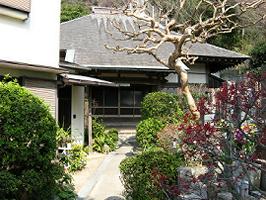
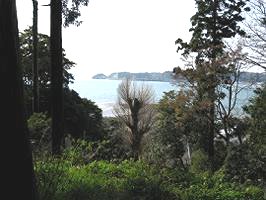
Location: 2.2 kilometers south of JR Kamakura Station
Grounds and structures: Shogakuji can be reached by climbing a steep stone stairway that leads up a hill on the left side of the road toward Zushi soon after passing Rokkaku no I Well. Within the grounds, which offer a picturesque view of Sagami Bay, and immediately to the left is a cluster of stone monuments: statues of stone Buddhas, a hokyointo-type stupa, a gorinto-type stupa, and in the center a stone monument bearing the inscription 三界万霊 (sangai manryo, literally, "ten thousand souls in the three realms"). In Buddhism, the three realms, among which all beings transmigrate, means: 1. the realm of desire, among others sexual desire and other appetites, which consists of hell, hungry spirits, animals, bellicose spirits, men, and part of heaven; 2. the realm of form, which comprises part of heaven, where beings have neither sexual desire nor other appetites; 3. the realm of non-form, where no material elements exists.
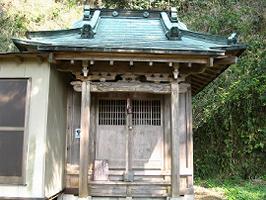
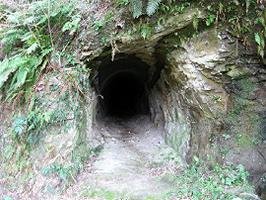
Ahead, you will see the Main Hall and the priest's living quarters. The grounds are said to have been where the Ryochu resided and propagated the teachings of the Jodo sect after traveling around the country. Built in 1541 by Kaiyo (快誉), the 18th Head Priest of Komyoji, Shogakuji Temple belongs to the Jodo sect, and the sango is Sumiyoshisan (住吉山).
The flight of stone steps behind the Main Hall will take you to Sumiyoshi Jinja Shrine (住吉神社), the tutelary deity of Iijima. The shrine probably also functioned as a guardian deity of Sumiyoshi Castle, since the castle's main entrance was once located on this spot.
This area is the former site of Sumiyoshi Castle and once under the control of Miura Yoshiatsu (三浦義同, 1464-1516), an influential warrior on the Miura Peninsula in the early Warring States period (1467-1590). He, later named himself Dosun (道寸), and it is under this latter name that he is best remembered.
Sumiyoshi Castle was built on the hill between Komyoji and Kotsubo to take advantage of the area's geographical features. Protected by hills, and with the sea to the west, it was in a natural stronghold, though it did not have a donjon as would normally be expected in a castle.
The only recorded mention of this castle states that it was attacked by and surrendered to the army of Hojo Soun (北条早雲, 1432-1519) in 1512 when Miura Doko (三浦道合, or道香), a younger brother of Dosun, was the castle lord.
The only remains are a man-made flat ground called kuruwa (曲輪) and a tunnel called Kurayami Yagura (くらやみやぐら). The tunnel, located to the right of Sumiyoshi Shrine, was a secret passage to the castle center. It is somewhat difficult to pass through because of its narrowness, two meters high and wide, and turns to the right some ten meters from the entrance. For an easy passage, a flashlight is recommended.